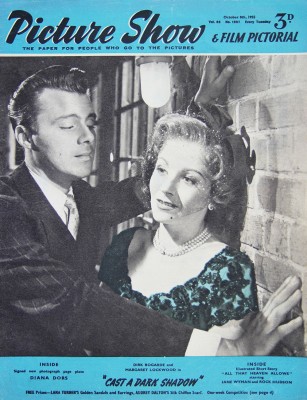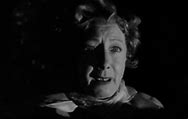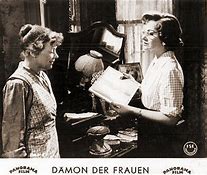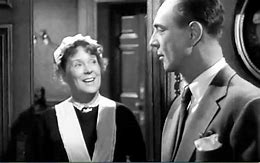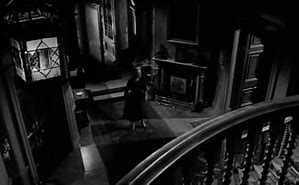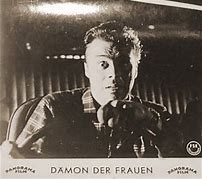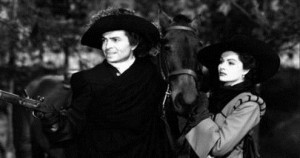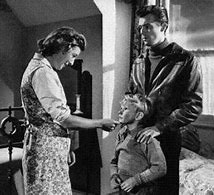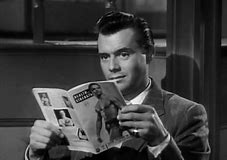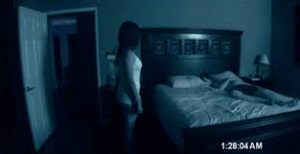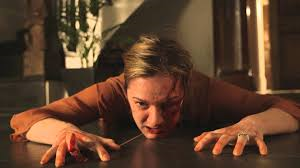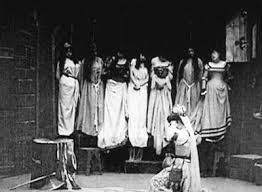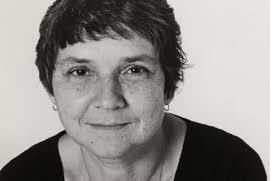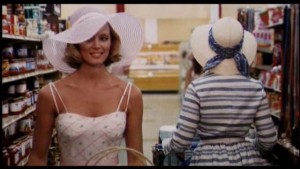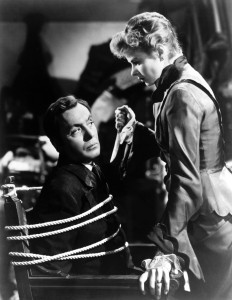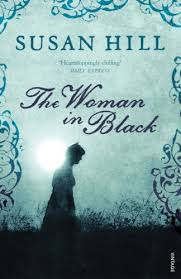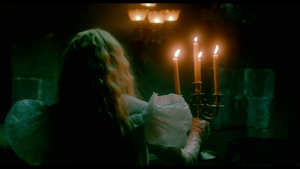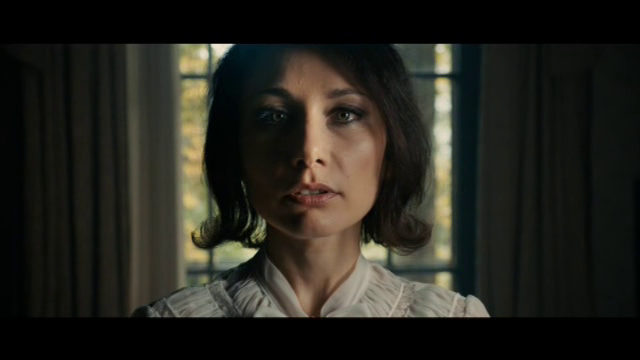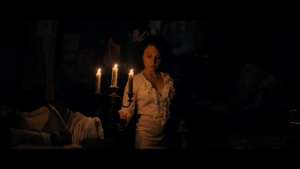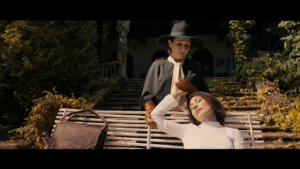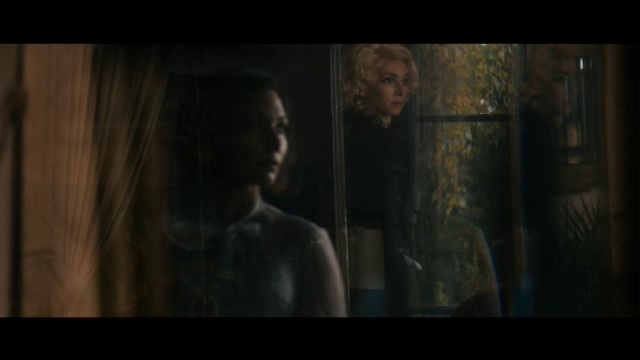We first listened to a copy of the radio version of The Yellow Wallpaper. This included the original advertisements before, within, and after the show. We discussed this especially in relation to Charlotte Perkins Gilman’s 1892 short story.
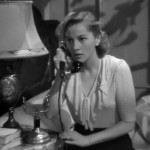 The unnamed heroine suggested connections to the second Mrs de Winter in Daphne du Maurier’s 1938 novel Rebecca. Because the radio dramatized action more than the short story – we ‘objectively’ heard conversations – the fact the narrator is not addressed by name by those around her is more evident. We especially noticed the terms used, like ‘pet’, ‘goose’ and ‘dope’.
The unnamed heroine suggested connections to the second Mrs de Winter in Daphne du Maurier’s 1938 novel Rebecca. Because the radio dramatized action more than the short story – we ‘objectively’ heard conversations – the fact the narrator is not addressed by name by those around her is more evident. We especially noticed the terms used, like ‘pet’, ‘goose’ and ‘dope’.
The issue of the audience the narrator was addressing was also raised. While in the radio version we hear the scratching of her writing, her thoughts are of course conveyed by her speech. Significantly this is not a simple rendering on the short story – a kind of journal. The aural medium almost precludes the need for writing, and makes the narrator seem both less and more cut off: we feel more connected to than since we appear to be more directly addressed, but this reveals that we are all she has.
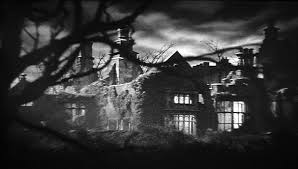 Indeed the speaker also seems more confined in terms of her activities (in the short story she goes riding) while the radio version foregrounds the house and the attic room. This is evident at the very beginning which opens with description of arriving at the house, which once more reminded us of both the novel and film versions of Rebecca. Significantly the narrator in the radio version of The Yellow Wallpaper describes the atmosphere as pertaining to ‘ghostliness’ and asks her husband if the house is ‘haunted’.
Indeed the speaker also seems more confined in terms of her activities (in the short story she goes riding) while the radio version foregrounds the house and the attic room. This is evident at the very beginning which opens with description of arriving at the house, which once more reminded us of both the novel and film versions of Rebecca. Significantly the narrator in the radio version of The Yellow Wallpaper describes the atmosphere as pertaining to ‘ghostliness’ and asks her husband if the house is ‘haunted’.
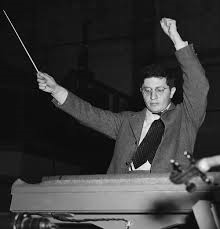 This nod to the gothic appeared far less subtle and ambiguous than the short story. It does, however, fit with the radio show Suspense’s focus on thrills and spills. (Well indicated by long-term Allred Hitchcock collaborator Bernard Herrmann’s theme tune to the series.) This also connects to the way in which the characters are portrayed. In the short story all is framed by being from the narrator’s point of view. The very fact we hear all characters in the radio version – and get seemingly ‘objective’ takes as to their attitude to the narrator – creates complexity. The husband and sister seem more reasonable in their tone. (Even though we found the husband’s declaration that ‘I’m a doctor and I know’ less than convincing, this could be attributed to concern and despair for his wife.) This is especially highlighted by the narrator’s speaking over such comments as they happen to assert her family’s bad treatment of her. A potential disconnect is therefore evident.
This nod to the gothic appeared far less subtle and ambiguous than the short story. It does, however, fit with the radio show Suspense’s focus on thrills and spills. (Well indicated by long-term Allred Hitchcock collaborator Bernard Herrmann’s theme tune to the series.) This also connects to the way in which the characters are portrayed. In the short story all is framed by being from the narrator’s point of view. The very fact we hear all characters in the radio version – and get seemingly ‘objective’ takes as to their attitude to the narrator – creates complexity. The husband and sister seem more reasonable in their tone. (Even though we found the husband’s declaration that ‘I’m a doctor and I know’ less than convincing, this could be attributed to concern and despair for his wife.) This is especially highlighted by the narrator’s speaking over such comments as they happen to assert her family’s bad treatment of her. A potential disconnect is therefore evident.
 This is furthermore connected to the decision to emphasise the narrator’s madness from earlier on than in the short story. It can be debated in both the short story and the radio version whether the narrator is already suffering from madness, is sent mad from being perfectly sane by her situation, or if a precondition is exacerbated by her family’s treatment of her. The short story is more open to interpretation, but the radio version has its own audience to consider. Since it would be a departure from the short story to reveal that the narrator is not mad, but in fact in danger from her husband, the nature of the radio series perhaps demanded a more straightforward, and less ambiguous approach. This was largely conveyed by Agnes Moorehead’s powerful acting of the narrator’s hysteria which fairly swiftly signals that she is unhinged. We found the scratching of writing on paper to the action of tearing the wallpaper, with her teeth, especially effective.
This is furthermore connected to the decision to emphasise the narrator’s madness from earlier on than in the short story. It can be debated in both the short story and the radio version whether the narrator is already suffering from madness, is sent mad from being perfectly sane by her situation, or if a precondition is exacerbated by her family’s treatment of her. The short story is more open to interpretation, but the radio version has its own audience to consider. Since it would be a departure from the short story to reveal that the narrator is not mad, but in fact in danger from her husband, the nature of the radio series perhaps demanded a more straightforward, and less ambiguous approach. This was largely conveyed by Agnes Moorehead’s powerful acting of the narrator’s hysteria which fairly swiftly signals that she is unhinged. We found the scratching of writing on paper to the action of tearing the wallpaper, with her teeth, especially effective.
The narrator’s confinement in the attic and its possible effect on her mental state was a point of discussion. We spoke a lot about the significance of it being a former nursery, and later a gymnasium for children – this infantilised her. The mention of bars and rings, to which she might be chained, in both the short story and radio versions made her confinement more concrete.
We found the ending of both versions especially powerful. The narrator is creeping or crawling, possibly on all fours, like a small child or indeed an animal. The latter is further suggested as we are told of a line at a certain height which is present around the whole room. In some ways, this suggests the tethering of an animal which is then only permitted to exercise in a reduced area. It was also mentioned that it was possible that she was kept in effectively, or indeed actually, in a padded cell.
 There were some jarring elements in the radio version, in addition to the heightened emotion. The tension is at times very heavily scored in a way which distances the listener from the intimate story. While they more closely mirrored the original listening experience of 1948, we found the appearance of advertisements throughout the drama disrespectful, disruptive and unsettling. While the break allowed for time to be moved on by 2 weeks (as mentioned by the narrator), we felt we had been taken too far away from the story by the insertion of dramatized advertisements; two men met the advertising spokesman and not only commented on their products- Autolite Spark Plugs – but also the drama and performances. We pondered whether a few references to cars were not only used to create a more contemporary setting than the 1892 short story, but to provide a connection with the advertiser’s product. We found it especially disturbing, and ironic, that the spark plugs evoked thoughts of Electro Convulsive Therapy. ECT was an intense, and now deeply controversial, treatment which is likely to have been used at the time for similar cases as the narrator.
There were some jarring elements in the radio version, in addition to the heightened emotion. The tension is at times very heavily scored in a way which distances the listener from the intimate story. While they more closely mirrored the original listening experience of 1948, we found the appearance of advertisements throughout the drama disrespectful, disruptive and unsettling. While the break allowed for time to be moved on by 2 weeks (as mentioned by the narrator), we felt we had been taken too far away from the story by the insertion of dramatized advertisements; two men met the advertising spokesman and not only commented on their products- Autolite Spark Plugs – but also the drama and performances. We pondered whether a few references to cars were not only used to create a more contemporary setting than the 1892 short story, but to provide a connection with the advertiser’s product. We found it especially disturbing, and ironic, that the spark plugs evoked thoughts of Electro Convulsive Therapy. ECT was an intense, and now deeply controversial, treatment which is likely to have been used at the time for similar cases as the narrator.
We also discussed The Yellow Wallpaper’s status as feminist tract. It was noted that the narrator’s exasperation that she was told to both exercise and rest (‘I can’t do both!’) reflected the double bind or the push/pull in many women’s lives. Furthermore we debated whether the heightened hysteria in the radio adaptation furthered, or diminished, its feminist clout. Some thought that the focus on madness made it harder to argue for it as feminist. Others argued that the drama was not preaching to the converted; it was heard by a wide US audience who perhaps would not have experience of Perkins Gilman’s short story. They might well, however, have been familiar with the presence of psychoanalysis in 1940s cinema and other popular culture. We can also consider that the show was staged again nearly ten years later, again with Moorehead, on the 30th of June 1957. This potentially reached more people at a later date.
We also commented on Elaine R. Hedges Afterword in the 1981 Virago Modern Classics edition. This mentioned that, according to Perkins Gilman, her father had abandoned the family when she was very young, as it was thought having more children would put Perkins Gilman’s mother in danger. (p. 42, this is quoted from her 1935 autobiography, published after her self-inflicted death in the face of terminal cancer). We spoke about the latitude it is likely that her father, but not her single parent mother, might have enjoyed; he could move away, and perhaps remarry bigamously and start another family. Such an option was not open to Perkins Gilman’s mother.
This led to discussion on the ways in which women are institutionalised when they do not conform to ‘norms’ while this is less true for men. A Spanish film in which a mother is sent to a lunatic asylum after the death of her child was mentioned. It was noted that now the woman was no longer fulfilling the mother role society had expected her to fill, she was classed insane. This was also related to Sarah Waters’ 2009 novel The Little Stranger. We extended this to consideration of single unmarried mothers and those in non-hetero normative relationships.
 Finally associations of the colour yellow were spoken about. It was noted that in addition to having connections with sickness and disease, it was more closely linked to mental illness through the work of Vincent Van Gogh, who suffered from severe depression and eventually took his own life because of it.
Finally associations of the colour yellow were spoken about. It was noted that in addition to having connections with sickness and disease, it was more closely linked to mental illness through the work of Vincent Van Gogh, who suffered from severe depression and eventually took his own life because of it.
Next we listened to and discussed The Diary of Sophronia Winters. This threw some of the issues from The Yellow Wallpaper into further relief and commented more directly on matters relating to the gothic.
 The episode was written as original Suspense story by Lucille Fletcher – also of Sorry Wrong Number fame. The version we listened to had the advertisements cut, allowing us to engage more with it than with The Yellow Wallpaper. It is set in 1932, as revealed by Sophronia mentioning that she is 40 and was born in 1892. Coincidentally, perhaps, this is the first publishing date of The Yellow Wallpaper.
The episode was written as original Suspense story by Lucille Fletcher – also of Sorry Wrong Number fame. The version we listened to had the advertisements cut, allowing us to engage more with it than with The Yellow Wallpaper. It is set in 1932, as revealed by Sophronia mentioning that she is 40 and was born in 1892. Coincidentally, perhaps, this is the first publishing date of The Yellow Wallpaper.
Again we spoke about the heroine. We wondered about the unusual name Sophronia. It means sensible and prudent, but such connotations are undercut almost immediately. Sophronia’s introductory narration (in which she is speaking to her diary) prattles about her ‘gorgeous new permanent wave’ and she is conveyed as giddy and frivolous. (We especially commented on Moorehead’s versatility both throughout his episode, as her fear grows into madness, and in comparison to her performance in The Yellow Wallpaper.)
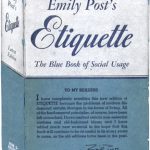 Sophronia views her life as beginning at 40 since she has spent the last ten years caring for her father before he died. This connects to the second Mrs de Winter’s situation in Rebecca – as indeed does her surname. Like the second Mrs de Winter, Sophronia is inexperienced – however she desperately wants to be experienced. This does not go as far as speaking to a gentleman first though. This shows 1930s Emily Post style decorum.
Sophronia views her life as beginning at 40 since she has spent the last ten years caring for her father before he died. This connects to the second Mrs de Winter’s situation in Rebecca – as indeed does her surname. Like the second Mrs de Winter, Sophronia is inexperienced – however she desperately wants to be experienced. This does not go as far as speaking to a gentleman first though. This shows 1930s Emily Post style decorum.
The evocation of St Petersburg, Florida, a playground with its beaches, bingo, alligator farms and sun and fun seekers, was deemed effective. One of the group commented on the accuracy as it was similar to her grandmother’s experience from around the time.
After the initial brisk opening, and the very hasty marriage of Sophronia to Hiram Johnson, the man she meets and who strikes up a relationship with her, events soon turn darker. This is especially seen as the newly married couple arrive at Hiram’s family home: a deserted 125 room gothic-style hotel a taxi driver has refused to take them to. Sophronia’s initial recoiling from this Old Dark House is substantiated when Hiram angrily rejects her suggestion they stay in town and physically harms her.
 It was noted that the US does not have old family piles (like Manderley in Rebecca) and that a large building is more likely to be a hotel than a mansion. The use of a hotel also signals the merging of the private and the public. If Sophronia has initially had concerns about Hiram, at least the couple will be in the presence of others. This turns out not to be the case and it is after Sophronia is made aware of this that she suggests they find another hotel. We also spoke about Stanley Kubrick’s The Shining (1980) in terms of a hotel’s potentially malevolent effect on someone staying there– in this case Hiram or Sophronia, or them both.
It was noted that the US does not have old family piles (like Manderley in Rebecca) and that a large building is more likely to be a hotel than a mansion. The use of a hotel also signals the merging of the private and the public. If Sophronia has initially had concerns about Hiram, at least the couple will be in the presence of others. This turns out not to be the case and it is after Sophronia is made aware of this that she suggests they find another hotel. We also spoke about Stanley Kubrick’s The Shining (1980) in terms of a hotel’s potentially malevolent effect on someone staying there– in this case Hiram or Sophronia, or them both.
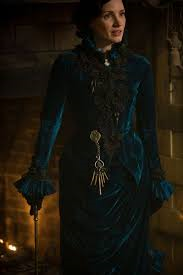 Hiram emphasises the locking of the gate behind them: after all, no one will be visiting – or leaving. The reference to locked rooms later – and the fact Hiram has a pass key to all the rooms- also draws on the gothic. We were especially reminded of women who are in fact in charge of the house keys (chatelaines) in such films as Rebecca (1940), Notorious (1946) and Crimson Peak (2015). In all of these the keys are controlled not by the heroine, but by her enemy: the housekeeper Danvers, her mother-in-law, and her sister-in-law. Sophronia does not have access to the keys, and therefore is not in charge of the space – Hiram is. This is especially well conveyed by Sophronia’s later pitiful reaction when she realises that on one occasion Hiram has left her room unlocked. He emphasises that there is still no way for her to escape since the front and back doors, all the fire escapes and most of the windows are locked. The very fact there are so many potential ways of escape, but that all of these are cut off to Sophronia, heightens the awfulness of her plight.
Hiram emphasises the locking of the gate behind them: after all, no one will be visiting – or leaving. The reference to locked rooms later – and the fact Hiram has a pass key to all the rooms- also draws on the gothic. We were especially reminded of women who are in fact in charge of the house keys (chatelaines) in such films as Rebecca (1940), Notorious (1946) and Crimson Peak (2015). In all of these the keys are controlled not by the heroine, but by her enemy: the housekeeper Danvers, her mother-in-law, and her sister-in-law. Sophronia does not have access to the keys, and therefore is not in charge of the space – Hiram is. This is especially well conveyed by Sophronia’s later pitiful reaction when she realises that on one occasion Hiram has left her room unlocked. He emphasises that there is still no way for her to escape since the front and back doors, all the fire escapes and most of the windows are locked. The very fact there are so many potential ways of escape, but that all of these are cut off to Sophronia, heightens the awfulness of her plight.
After they enter the house, Sophronia hears more about the namesake Hiram has earlier referred to – his sister-in-law, Sophronia Johnson. (We even wondered whether the assertion they share the same first name was an invention on his part.) Hiram reveals that Sophronia Johnson murdered his brother with a fire axe. Hiram’s earlier way of inveigling a relationship with Sophronia was to mention while they were collecting 9 pointed starfish that his sister-in-law too enjoyed that hobby too. Now he points to a further connection: he shows Sophronia a portrait of his sister-in-law and insists on a physical similarity. Since we cannot see this portrait, it is ambiguous whether there is a likeness, but Sophronia’s response suggests recognition of little more than a passing resemblance. The use of the gothic trope of the portrait, and Hiram’s increasingly demented behaviour, further bodes ill for our heroine.
Before long, Hiram is offering to show Sophronia his sister-in-law’s grave in the grounds in the middle of the suitably stormy night. Even more disturbingly, he tells of the graves of the other ‘Sophronias’ he has hunted down. Hiram replies to Sophronia’s question of whether Sophronia Johnson haunts the grounds, that the ‘she-devil’ is a ‘restless sleeper’ often found in ‘disguise’ in ‘warmer climes’ – like St Petersburg. The terror escalates as Hiram states he always has an open grave ready – for the next time he finds Sophronia…
Sophronia Winters is heard to be especially in peril as after her night time excursion her coughing is focused on. While the episode was unfolding, some wondered if this signalled to Hiram’s poisoning of his wife. He appears superficially solicitous, however, suggesting she stay warm and perhaps fetch Sophronia Johnson’s dressing gown from her wardrobe. These scenes in Sophronia’s bedroom (which used to belong to Sophronia Johnson) are especially unsettling. Hiram comments that Sophronia seems to be familiar with the room. She denies this, and puts her odd behaviour down to the fact that it just seems odd since the room has a sense of being lived in. Later, Hiram notes that Sophronia has the embroidery his sister-in-law enjoyed working on in her hand. This surprises Sophronia, and perhaps suggests to the audiences that the Sophronias are merging – or perhaps they have always been the one person. This is an especially interesting take on the concept of the double used in the Gothic.
Such merging of the Sophronias becomes more pronounced as Hiram asks Sophronia to sing a hymn for him while he plays the harmonium. This mirrors the situation when Sophronia Johnson killed Hiram’s brother, and indeed Hiram appears to almost be setting the stage for another such occurrence. Despite his seeming manipulation, Hiram still seems surprised when confronted by Sophronia and the fire axe.
 We spoke further about Hiram’s character. We thought that he represented a Bluebeard character- but unusually one with a motive, at least in his own mind. We also commented on Hiram’s age – we thought he sounded about 50, which is similar to the stated age of his family hotel in Maine. This ties Hiram to the hotel space more closely, perhaps even making it complicit in his campaign of terror.
We spoke further about Hiram’s character. We thought that he represented a Bluebeard character- but unusually one with a motive, at least in his own mind. We also commented on Hiram’s age – we thought he sounded about 50, which is similar to the stated age of his family hotel in Maine. This ties Hiram to the hotel space more closely, perhaps even making it complicit in his campaign of terror.
The epilogue of the episode elicited much discussion about whether Sophronia had been driven insane. Sophronia asks a nurse if her ‘dear brother-in-law Hiram’ is dead. This is confirmed, and Sophronia hysterically claims responsibility. While this may signal a medical professional simply indulging her patient, it also suggests that interpretations other than Hiram having sent Sophronia mad are possible. After all, she is Hiram’s widow, not his sister-in-law. Or is she in fact Sophronia Johnson, who Hiram claims he keeps finding? Or is the entire Diary a reflection of Sophronia Johnson’s fevered imagination (perhaps she killed both her husband and Hiram at the time) in which she invents a new role for herself as Sophronia Winters and creates the whole narrative we hear?
Taking the story at face value, and assuming that the women were separate people (or indeed that Sophronia Johnson perhaps never existed), we were pleased to hear that Sophronia was able to protect herself physically from Hiram. As with The Yellow Wallpaper, we also mentioned the way in which women were contained. While the deranged Hiram was allowed to roam the country, Sophronia is at the end institutionalised. We would have preferred to hear of her successfully running the hotel, or indeed for a twist to reveal that she was now searching for Hirams in Florida…
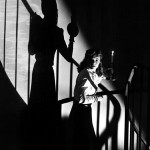 We also spoke of the effectiveness of some of the sound effects in establishing space and atmosphere. The hotel’s creaking doors and ticking clock spoke of age and the uncontrollable passage of time. The fog horn convincingly evoked dreary outside space and the harmonium was a suitably creepy musical instrument to employ. We compared it to the use of the Theremin in The Spiral Staircase (1945).
We also spoke of the effectiveness of some of the sound effects in establishing space and atmosphere. The hotel’s creaking doors and ticking clock spoke of age and the uncontrollable passage of time. The fog horn convincingly evoked dreary outside space and the harmonium was a suitably creepy musical instrument to employ. We compared it to the use of the Theremin in The Spiral Staircase (1945).
Finally, it is worth mentioning that the episode was restaged on the 17th of August 1944 – once more with Moorehead and Ray Collins. On the 10th of August 1958 the roles were taken by Mercedes McCambridge and Jerry Hausner.
We concluded with comments drawing together our experiences of the twoi narratives. Both The Yellow Wallpaper and The Diary of Sophronia Winters are tales told by women (played by Moorehead on the radio) who express themselves in writing. They are advised not to by male doctors. The narrator’s husband in The Yellow Wallpaper suggests she should not write, while at the end of The Diary of Sophronia Winters the nurse tells Sophronia the doctor does not approve of her doing so.
Both women are in peril – from their own madness. Whether this is deliberately or unthinkingly brought on, or made worse, by their husbands is a moot point. Fletcher’s episode takes the matter of Gothic further, as she provides a checklist of tropes: the hasty marriage, the tormenting husband, the creepy house, the locked rooms, the portrait and the notion of the Double.
Neither of these stories suggests that marriage is a good idea and the Gothic as a whole questions the rights and consequences of patriarchy. We thought it was especially significant that this wariness of marriage was present most strikingly in The Diary of Sophronia Winters, first broadcast in 1943. This was a time when hasty marriages were being entered into as men were called away to war. By the time of The Yellow Wallpaper radio version (in 1948) this was less pressing and suggest perhaps another reason, other than the format and the original story, for the heightened hysteria of the narrator from earlier in the narrative.
As ever, do log into comment, or email me on sp458@kent.ac.uk to add your thoughts.
Old Time Radio Links:
The Yellow Wallpaper:
29th of July 1948: https://www.oldtimeradiodownloads.com/thriller/suspense/yellow-wallpaper-1948-07-29
30th of June 1957: https://www.oldtimeradiodownloads.com/thriller/suspense/the-yellow-wallpaper-1957-06-30
The Diary of Sophronia Winters
27th of April 1943: https://www.oldtimeradiodownloads.com/thriller/suspense/the-diary-of-sophronia-winters-1943-04-27
17th of August 1944: https://www.oldtimeradiodownloads.com/thriller/suspense/the-diary-of-sophronia-winters-1944-08-17
10th of August 1958: https://www.oldtimeradiodownloads.com/thriller/suspense/diary-of-sophronia-winters-1958-08-10


